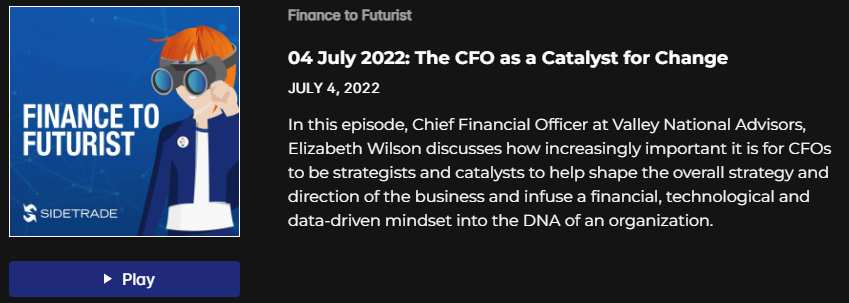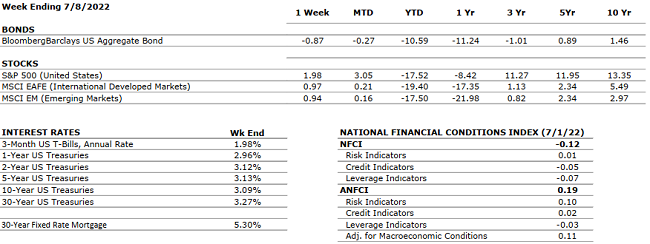Our CFO, Elizabeth Wilson, is a featured guest on the Sidetrade Finance to Futurist podcast July 4 episode. LISTEN NOW – 04 July 2022: The CFO as a Catalyst for Change – Finance to Futurist (sidetrade.com)


Our CFO, Elizabeth Wilson, is a featured guest on the Sidetrade Finance to Futurist podcast July 4 episode. LISTEN NOW – 04 July 2022: The CFO as a Catalyst for Change – Finance to Futurist (sidetrade.com)

Despite catastrophic headlines globally such as the assassination of former Japanese Prime Minister Shinzo Abe, and the continued war ravaging Ukraine, the main market influencing issue is the seemingly unstoppable inflationary pressures worldwide. Further, China is again attempting to solidify its military grasp on Hong Kong. Regardless of these negative headwinds, the markets turned in a decisively positive week with the Dow Jones Industrial Average returning +1.8%, the S&P 500 Index notching +3.0% for the week and the NASDAQ returning a healthy +5.5% last week.
Markets (as of 7/8/2022; change YTD)

Global Economy
30-year fixed mortgage rates in the U.S. dropped for the second week in a row, from 5.70% to 5.30%. This is the largest weekly decline since the Global Financial Crisis, when rates fell from 5.97% to 5.53% in December 2008. Chart 1 shows mortgage rates over the prior year. This decrease reflects widespread recessionary fears and an obvious slowing in the housing sector.
Chart 1: Average rate on a 30-year fixed mortgage

Chinese annual inflation numbers surprised to the upside in June with China’s National Bureau of Statistics claiming that consumer prices rose by 2.5%, up from 2.1% in May and higher than the expected 2.4%. Production prices remained lower with 6.1% inflation, down from 6.4% in May and down from the recent high of 13.5% recorded in October 2021.
Last week, Federal Reserve Chair Jerome Powell acknowledged that the recent 75 basis point rate hikes increase the chances of an economic downturn in the foreseeable future. The stated idea behind this is to prevent a shift in consumer psychology that inflation will persist, which would create an inflationary feedback loop. Chart 2 shows consumers’ inflation expectations over the next one and five years; with the salient point being that consumers do not believe inflation to be long-lasting, at this point in the economic cycle.
Chart 2: Consumers’ inflation expectations

Policy and Politics
As Congress reconvenes in Washington this week, several items are on the agenda, including the potential codification of abortion rights into federal law, the onshoring of semiconductor manufacturers to the U.S. as part of the China bill, lowering prescription drug prices, and potentially raising taxes on corporations and high-income households.
What to Watch
THE NUMBERS
The Sources: Index Returns: Morningstar Workstation. Past performance is no guarantee of future results. Indices are unmanaged and cannot be invested into directly. Three, five and ten year returns are annualized. Interest Rates: Federal Reserve, Mortgage Bankers Association.
MARKET HEAT MAP
The health of the economy is a key driver of long-term returns in the stock market. Below, we assess the key economic conditions that we believe are of particular importance to investors.
|
US ECONOMY |
||
|
CONSUMER HEALTH |
NEUTRAL |
Q1 2022 Real GDP shrunk at a 1.5% annual rate according to the second estimate. This is the first contraction since the beginning of the pandemic. The main factors that resulted in a decrease in GDP were a surge in imports and trade deficit highlighting that the U.S. is buying more goods from foreign countries. This may be an indication that the U.S. economy has recovered faster than other countries. |
|
CORPORATE EARNINGS |
NEUTRAL |
The earnings growth rate for Q1 2022 was 9.2% — the lowest since Q4 2020 (3.8%). This estimate was revised upward from the previous forecast of 7.1% in April. All S&P500 companies have reported earnings — 77% reported a positive EPS surprise and 73% beat revenue expectations. The estimated growth rate for Q2 2022 is now 4.3% which would mark a new post-pandemic low; but still solidly in the “growth” stage. |
|
EMPLOYMENT |
POSITIVE |
Total nonfarm payroll employment rose by 370,000 in June and the unemployment rate remained constant at 3.6%. Job growth was widespread, led by gains in leisure and hospitality, manufacturing, and transportation and warehousing. Employment in retail trade declined. |
|
INFLATION |
NEGATIVE |
CPI rose 8.6% year-over-year in May 2022, the largest increase since December 1981. Core CPI recorded a 6.0% increase (down slightly from April). The increase in CPI was driven by energy, food, and shelter. After declining in April, energy increased by 3.9% over May and gasoline rose by 4.1%. |
|
FISCAL POLICY |
NEUTRAL |
After passing a $13.6 billion package to support Ukraine a few weeks ago, the House approved an additional $40 billion military and humanitarian package for Ukraine. The bill was passed with 368 votes against 57 votes. The total of the two packages ($53 billion) is the largest foreign aid moved through Congress in over 20 years. |
|
MONETARY POLICY |
NEUTRAL |
The Fed responded to the persistent inflation numbers by raising rates by 75 basis points, the highest hike since November 1994. Powell mentioned that another 50 to 75 bps hike is likely for July. The next decisions by the Fed will be data-driven based on future inflation numbers and estimated economic growth. |
|
GLOBAL CONSIDERATIONS |
||
|
GEOPOLITICAL RISKS |
NEGATIVE |
Russia has defaulted on its debt as of Sunday, June 26th when the 30-day grace period on $100 million of interest payments expired. This is the first Russian default since 1918. Sanctions imposed by Western powers effectively isolated Russia and its financial system from Europe and the U.S. making it much harder for Russia to complete international financial transactions. |
|
ECONOMIC RISKS |
NEUTRAL |
Supply chain disruptions in the U.S. are waning but the rising cost of oil due to the Russian- Ukraine war is likely to cause additional inflationary pressures not only on gasoline prices but also on many other goods and services. Starting in June, China has started to remove some restrictions in major cities to end the COVID-19 lockdown. |
The “Heat Map” is a subjective analysis based upon metrics that VNFA’s investment committee believes are important to financial markets and the economy. The “Heat Map” is designed for informational purposes only and is not intended for use as a basis for investment decisions.
“If people sat outside and looked at the stars each night, I’ll bet they’d live a lot differently.” – Bill Watterson
Tune in Wednesday, 6 PM for “Your Financial Choices” with Laurie Siebert on WDIY 88.1FM. Laurie will be joined by VNFA’s CIO, Bill Henderson, to discuss: 2022 Half-Year Review.
Laurie can address questions on the air that are submitted either in advance or during the live show via yourfinancialchoices.com. Recordings of past shows are available to listen or download at both yourfinancialchoices.com and wdiy.org.